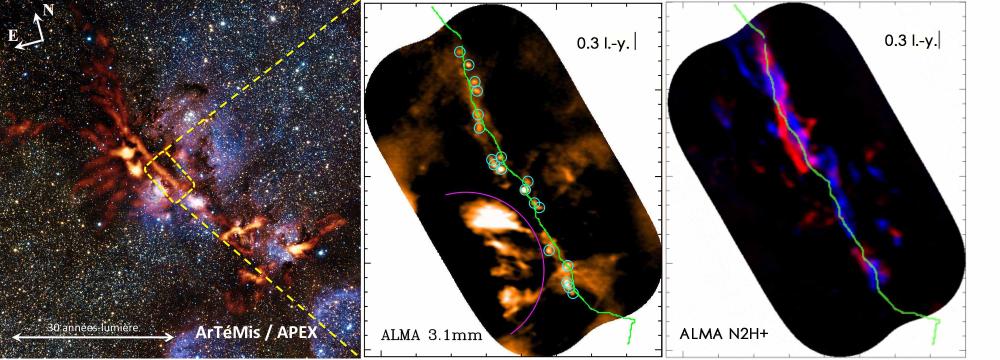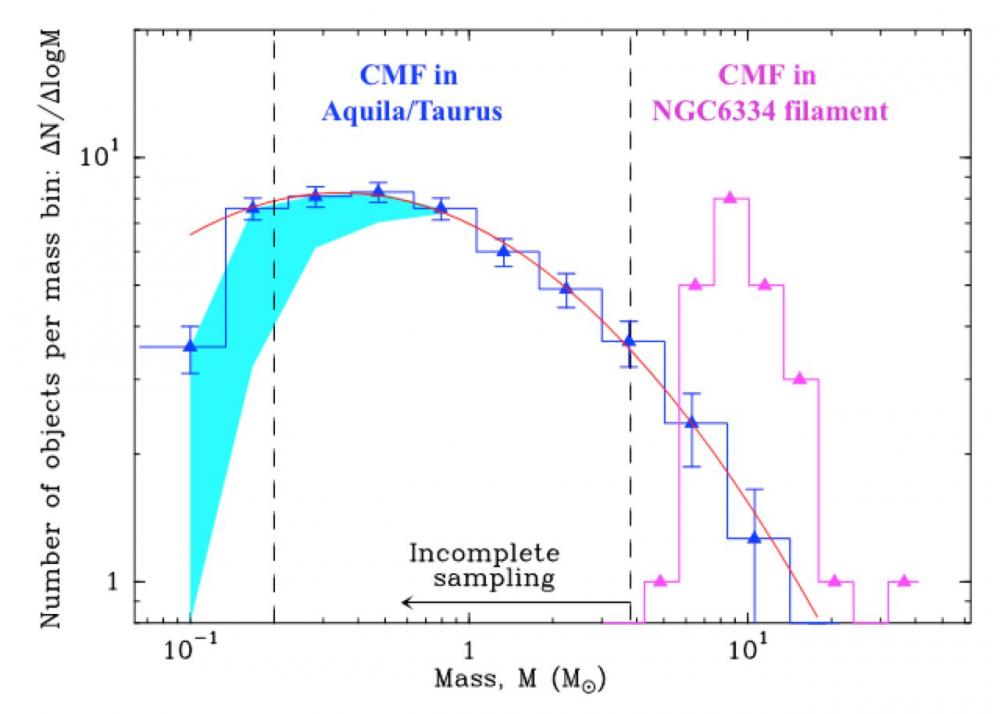An international team led by the Astrophysics Department-AIM Laboratory of CEA-Irfu has just obtained new clues about the origin of star mass distribution, combining observational data from the large interferometer ALMA and the APEX radio telescope operated by the European Austral Observatory (ESO) and the Herschel Space Observatory. Thanks to ALMA, the researchers have discovered in the so-called Cat's Paw Nebula, located at about 5,500 light-years, the presence of protostellar dense cores much more massive than those observed in the solar vicinity. Researchers have shown that there is a close link between the mass distribution of interstellar filaments and the mass distribution of stars. The density - or mass per unit length - of the parent filaments is the crucial parameter that controls the masses of newly-formed stars. This discovery provides a key clue to the origin of stellar masses. These results are published in three articles of the journal Astronomy & Astrophysics.
The enigma of stellar masses
Stars are major building blocks of the Universe and the life of a star is almost entirely determined by its initial mass. But, the origin of the mass distribution of stars at birth - called the initial mass function by astronomers - is still an unresolved issue. It has long been thought that stars are formed by the collapse of more or less spherical interstellar clouds. But from 2009, the Herschel space observatory, observing in the far infrared and submillimeter, has allowed a fundamental breakthrough by revealing that stars are born mainly in dense filaments of cold gas. When these long filaments of gas, at a temperature of barely ~ 10 K (10 degrees above absolute zero), reach a critical density threshold of approximately 5 solar masses per light-year of length, the mass concentration becomes sufficient to form stars.
By observing interstellar clouds in the solar neighborhood, the results of the Herschel satellite have shown that star-forming filaments are all about the same width, close to ~ 0.3 light-years. In these clouds, the characteristic mass of stars formed by fragmentation of filaments is approximately ~ 0.3 solar mass.
But the sensitivity and resolution of the Herschel satellite images were insufficient to study this fragmentation process in more distant clouds. To better understand how stars that are significantly more massive than our Sun can form in interstellar filaments, astronomers have had to use instruments with higher resolution capabilities than Herschel, such as the ArTéMiS camera on the APEX radio telescope and the large ALMA interferometer, both located in the Atacama Desert in Chile.

On the left: image of the massive star-forming region NGC 6334, known as the Cat's Paw, seen by the ArTéMiS camera in cold dust emission at 350 µm (orange-red, superimposed on a near-infrared image from the ESO telescope VISTA at Mount Paranal). In the center: image by ALMA of the central region of the filament in emission of cold dust. Many protostellar condensations (light blue circles) are detected along the crest of the filament (marked by the green curve). On the right: ALMA image of the dense molecular gas in the same field (N2H+) molecule). Two intertwined "fibers" are detected. Copyright : ArTéMiS team/ALMA (ESO/NAOJ/NRAO); Ph. André, Y. Shimajiri
More massive stars in denser filaments?
The ALMA study focused on a massive star-forming region known as NGC 6334, also known as the Cat's Paw Nebula, located approximately 5500 light years from Earth. This nebula was one of the first regions "photographed" by the ArTéMiS camera observing at the wavelength of 350 μm. The ArTéMiS image revealed that the main filament has a width of about 0.5 light-years, very similar to that measured with Herschel for filaments in the solar neighborhood. The mass per unit length of this filament - about 300 solar masses per light-year - is however more than twenty times higher than the line mass of most of the filaments observed in the solar neighborhood.
Researchers from the AIM laboratory could then map part of the Cat's Paw filament using the ALMA interferometer. In turn, the ALMA image showed that the structure of the filament is very similar to that of solar neighborhood filaments, made of intertwined "fibers" or braids and protostellar condensations. But these proto-stellar condensations are here an order of magnitude more massive. It thus appears that the interstellar filaments fragment qualitatively in a very similar way, regardless of their density, but that the characteristic mass of protostellar condensations - and thus stars - which results from filament fragmentation increases with the linear density of the filaments.
This close relationship, demonstrated for the first time, reinforces the idea that star formation in filaments of dense molecular gas is perhaps a quasi-universal process. Such filaments represent fundamental "bulding blocks" of star birth and the filament density (or mass per unit of length) appears to be the critical parameter which finally decides the masses of the formed stars. The mass distribution of stars would thus be partly "inherited" from the distribution of filament linear densities.
But the enigma of stellar masses is not yet fully resolved. A new question arises as a result of this work: what is the origin of the density distribution of star-forming filaments? The researchers suspect that the magnetic field and the organization of the field lines inside the filaments plays a crucial role here. The B-BOP instrument, the polarimetric imager of the SPICA (SPace Infrared telescope for Cosmology and Astrophysics) project for the cryogenic infrared space telescope proposed as the M5 mission of the European Space Agency (ESA), should make it possible to test this hypothesis in the future.

Mass distribution of protostellar condensations detected with ALMA in the Cat's Paw filament (histogram in magenta) compared to a similar mass distribution observed with Herschel in solar neighborhood clouds such as Aquila or Taurus (histogram in blue). The filament of the Cat's Paw nebula forms protostellar condensations, and thus probably stars, about ten times more massive than the less dense filaments of the solar neighborhood.
Contact : Philippe ANDRE
Publications :
- « Probing fragmentation and velocity sub-structure in the massive NGC 6334 filament with ALMA » Y. Shimajiri, Ph. André, E. Ntormousi et al. (2019), in press in Astronomy & Astrophysics (Voir : https://arxiv.org/abs/1910.02622)
- « Properties of the dense core population in Orion B as seen by the Herschel Gould Belt survey »
V. Könyves, Ph. André, D. Arzoumanian et al. (2019), in press in Astronomy & Astrophysics (Voir : https://arxiv.org/abs/1910.04053)
- « The role of molecular filaments in the origin of the prestellar core mass function and stellar initial mass function »
Ph. André, D. Arzoumanian, V. Könyves et al. (2019), Astronomy & Astrophysics (Letters), 629, L4
- « Characterizing the properties of nearby molecular filaments observed with Herschel »
D. Arzoumanian, Ph. André, V. Könyves et al. (2019), Astronomy & Astrophysics, 621, A42
ALMA is a partnership of ESO (representing its member states), NSF (USA) and NINS (Japan), together with NRC (Canada), NSC and ASIAA (Taiwan), and KASI (Republic of Korea), in cooperation with the Republic of Chile. The Joint ALMA Observatory is operated by ESO, AUI/NRAO and NAOJ.
APEX is a collaboration between the Max Planck Institute for Radio Astronomy (MPIfR), the Onsala Space Observatory (OSO) and ESO. Operation of APEX at Chajnantor is entrusted to ESO.
See also : The ArTéMiS caméra operational at 5100 m altitude (11 March 2017)
Stars are born in dense filaments (06 June 2016)
Diving in the heart of the formation of stars with ArTéMiS (25 Septembre 2013)
Content: Ph. André, J.M. Bonnet-Bidaud
• Structure and evolution of the Universe › Planets, star's formation and dynamics, interstellar medium
• Department of Astrophysics (DAp) // UMR AIM




